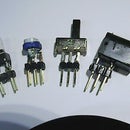Introduction: Hidden Arduino Thermometer
Did you know that many Arduinos and ATtiny chips have a built-in thermometer? The temperature is not calibrated, so you must take a couple of readings to characterize it. I found the original idea in the article - Secret Thermometer . I have added support for the Leonardo as well as several ATtinys, and provided a function for characterizing it.
Reading the Temperature Sensor
Here is the code for reading the raw data:
Massaging the Raw Data
Once you have the raw data, you can calibrate it by measuring two known temperatures and scaling as appropriate. Here is a simple little function to perform that normalization:
Calibrating
To get the four constants needed, simply run the sketch/program calling the
I have tested this code on the Leonardo, but it should also work on the Uno, and ATtinyx4 & ATtinyx5 series chips as well. If you like this trick, there is a companion instructable/article on measuring Vcc using the internal 1.1 volt reference that may be of interest as well.
Reading the Temperature Sensor
Here is the code for reading the raw data:
long readTemp() {
// Read temperature sensor against 1.1V reference
#if defined(__AVR_ATmega32U4__)
ADMUX = _BV(REFS1) | _BV(REFS0) | _BV(MUX2) | _BV(MUX1) | _BV(MUX0);
ADCSRB = _BV(MUX5); // the MUX5 bit is in the ADCSRB register
#elif defined (__AVR_ATtiny24__) || defined(__AVR_ATtiny44__) || defined(__AVR_ATtiny84__)
ADMUX = _BV(REFS1) | _BV(MUX5) | _BV(MUX1);
#elif defined (__AVR_ATtiny25__) || defined(__AVR_ATtiny45__) || defined(__AVR_ATtiny85__)
ADMUX = _BV(REFS1) | _BV(MUX3) | _BV(MUX2) | _BV(MUX1) | _BV(MUX0);
#else
ADMUX = _BV(REFS1) | _BV(REFS0) | _BV(MUX3);
#endif
delay(2); // Wait for ADMUX setting to settle
ADCSRA |= _BV(ADSC); // Start conversion
while (bit_is_set(ADCSRA,ADSC)); // measuring
uint8_t low = ADCL; // must read ADCL first - it then locks ADCH
uint8_t high = ADCH; // unlocks both
long result = (high << 8) | low; // combine the two
return result;
}Massaging the Raw Data
Once you have the raw data, you can calibrate it by measuring two known temperatures and scaling as appropriate. Here is a simple little function to perform that normalization:
float normalizeTemperature(long rawData) {
// replace these constants with your 2 data points
// these are sample values that will get you in the ballpark (in degrees C)
float temp1 = 0;
long data1 = 274;
float temp2 = 25.0;
long data2 = 304;
// calculate the scale factor
float scaleFactor = (temp2 - temp1) / (data2 - data1);
// now calculate the temperature
float temp = scaleFactor * (rawData - data1) + temp1;
return temp;
}Calibrating
To get the four constants needed, simply run the sketch/program calling the
readTemp() function at room temperature. Note the temperature and the raw data point. Enter these values for either set of data points. Next, either put your Arduino in the fridge or the oven (at a really low setting) and measure your second two data points. Replace the four constants with your data. It does not matter which order you list them. You can also enter your data in either Celsius or Fahrenheit. The linear calculation is independent of units as long as you are consistent in which system you use.I have tested this code on the Leonardo, but it should also work on the Uno, and ATtinyx4 & ATtinyx5 series chips as well. If you like this trick, there is a companion instructable/article on measuring Vcc using the internal 1.1 volt reference that may be of interest as well.

Participated in the
Electronics Tips and Tricks













